Table of contents
Table of Contents
- Char Dham yatra
- Hemkund Sahib: A Journey to the Roof of the Divine
- Tungnath: The Highest Shiva Temple in the World
- Mukteshwar🌲: The Hidden Gem of Kumaon
- Haridwar🌊: The Gateway to the Gods
- Rudranath Temple🕉️: The Face of Shiva in the Heart of the Himalayas
- 🕉️ Kalpeshwar Temple, Uttarakhand: The Eternal Blessing of Lord Shiva’s Locks
- 🕉️ Madhyamaheshwar Temple: Where Shiva’s Navel Rises from the Earth
- 🕉️Jageshwar Dham, Uttarakhand: Valley of Ancient Temples Where Shiva Resides
- 🕉️ Neelkanth Mahadev Temple, Uttarakhand: Where Shiva Drank the Poison of the Cosmos
- 🕉️ Dhari Devi Temple – Guardian Goddess of Uttarakhand
- 🕉️ Rishikesh: Gateway to the Himalayas & the Soul
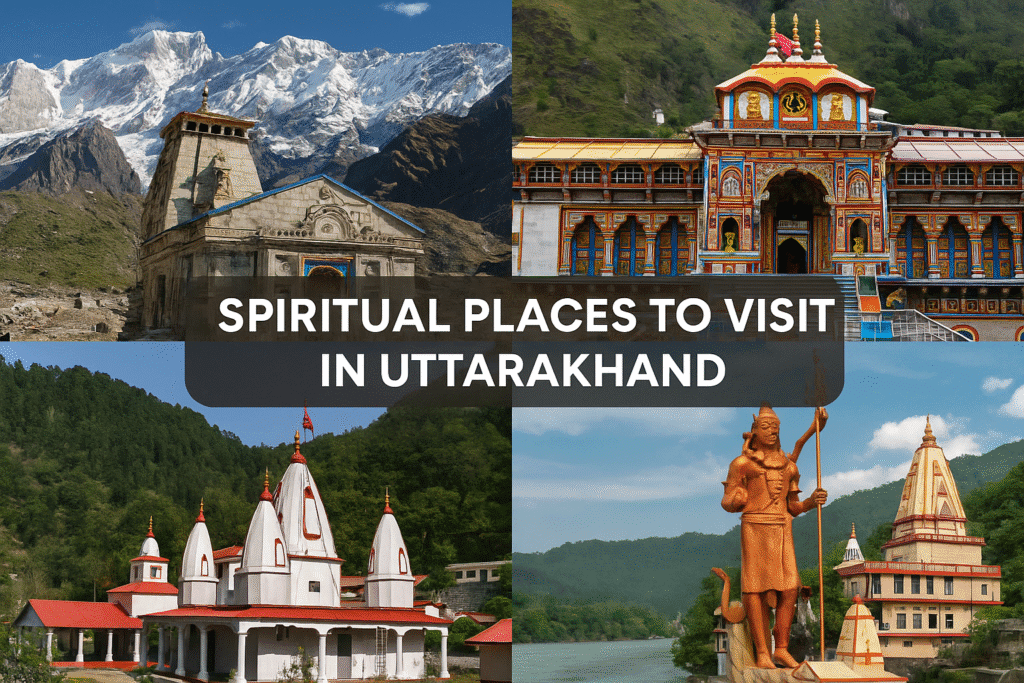
Uttarakhand, often called ‘Devbhoomi‘, is a sacred region where the voice of God reverberates through snow-capped peaks, ancient temples, and the sacred rivers Ganga and Yamuna. This mystical state of North India is a sanctuary for the soul, drawing millions of people in a spiritual quest to its eternal pilgrimage sites and serene Himalayan towns. From the transformative Char Dham Yatra to the hidden ashrams of the Himalayas, every corner of Uttarakhand oozes spiritual energy. Whether you are looking for inner peace, divine blessings, or a deep connection with nature, the spiritual places of Uttarakhand offer a journey that nourishes the heart and uplifts the soul.
Char Dham yatra
The Char Dham Yatra is one of the most important spiritual journeys in India, especially for Hindus. Located in the majestic Himalayas of Uttarakhand, this journey includes visiting four holy temples: Yamunotri, Gangotri, Kedarnath and Badrinath. Each site is dedicated to a different deity and offers a unique experience of peace, devotion and natural beauty.
Thousands of pilgrims from across the country and abroad visit this yatra every year to seek blessings and connect with God. Whether you are religious or just love mountains, the Char Dham Yatra is a life-changing experience filled with breathtaking views, ancient temples, and powerful spiritual energy.
Char Dham yatra temples:
- Gangotri – Source of the Ganga River.
- Yamunotri – Source of the Yamuna River.
- Badrinath Temple – Dedicated to Lord Vishnu.
- Kedarnath Temple – Dedicated to Lord Shiva.
1. 🕉️Gangotri– Source of the Sacred Ganga River.
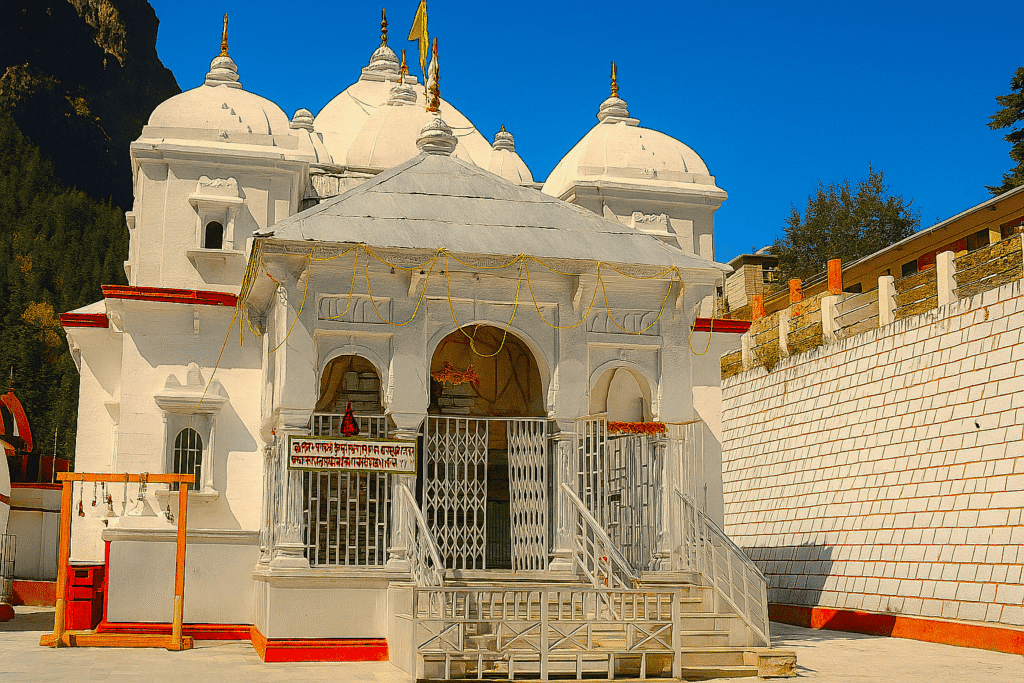
Gangotri is a serene and spiritually powerful town located in the Uttarkashi district of Uttarakhand. It is one of the four sacred sites in the Chota Char Dham Yatra and is the origin of the Ganges River, one of the holiest rivers in Hinduism. Located at an altitude of 3,100 meters, Gangotri is surrounded by the snow-clad Garhwal Himalayas, dense forests and the rushing waters of the Bhagirathi River, which becomes the Ganges after Devprayag.
At the centre of the town is the Gangotri Temple, a stunning white granite structure dedicated to Goddess Ganga. According to Hindu mythology, it is believed that Ganga descended to earth at this very spot to wash away the sins of King Bhagirath’s ancestors. The temple was built in the 18th century and remains a major pilgrimage site, attracting thousands of devotees every year.
A trip to Gangotri is not only spiritually rewarding but also a visual treat. The scenic drive, the sound of the rushing river currents and the presence of snow-capped peaks make for an unforgettable experience. Adventure seekers often trek from Gangotri to Gaumukh, which is the actual glacier from where the Ganges originates.
The temple is open between May and November, and during this time, the entire area turns into a vibrant hub of spirituality and natural beauty.
2. Yamunotri🌼– Source of the Sacred Yamuna River.
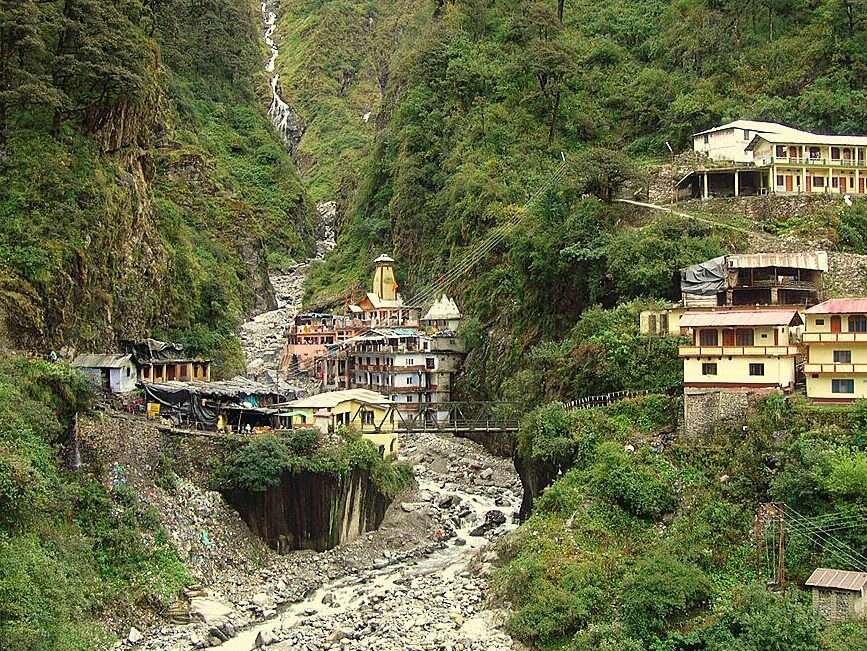
Yamunotri is the first stop of the Char Dham Yatra in Uttarakhand and is the origin of the Yamuna river, which is considered the sister of the Ganges and has deep spiritual significance in Hinduism. Situated at an altitude of 3,293 metres in Uttarkashi district, Yamunotri is surrounded by high Himalayan peaks, hot water springs and breathtaking landscapes.
The main attraction here is the Yamunotri Temple, dedicated to Goddess Yamuna, built in the 19th century by Maharani Guleria of Jaipur. To reach the temple, one has to cover a distance of 6 km from Janaki Chatti, and the journey offers views of waterfalls, alpine forests and snow-capped peaks. It is said that bathing in the waters of the Yamuna absolves one of sins and protects one from untimely death.
Near the temple are Surya Kund and Divya Shila, two sacred hot springs where pilgrims offer cooked rice and potatoes in cloth bags as offerings to the goddess. Though Yamunotri is less commercialised than the other Char Dham sites, its serene location and spiritual atmosphere make it a profound experience.
The temple is open from April/May to October/November, after which the area is covered with heavy snow during winter.
3. Badrinath Temple🛕 – A Divine Retreat in the Himalayas.
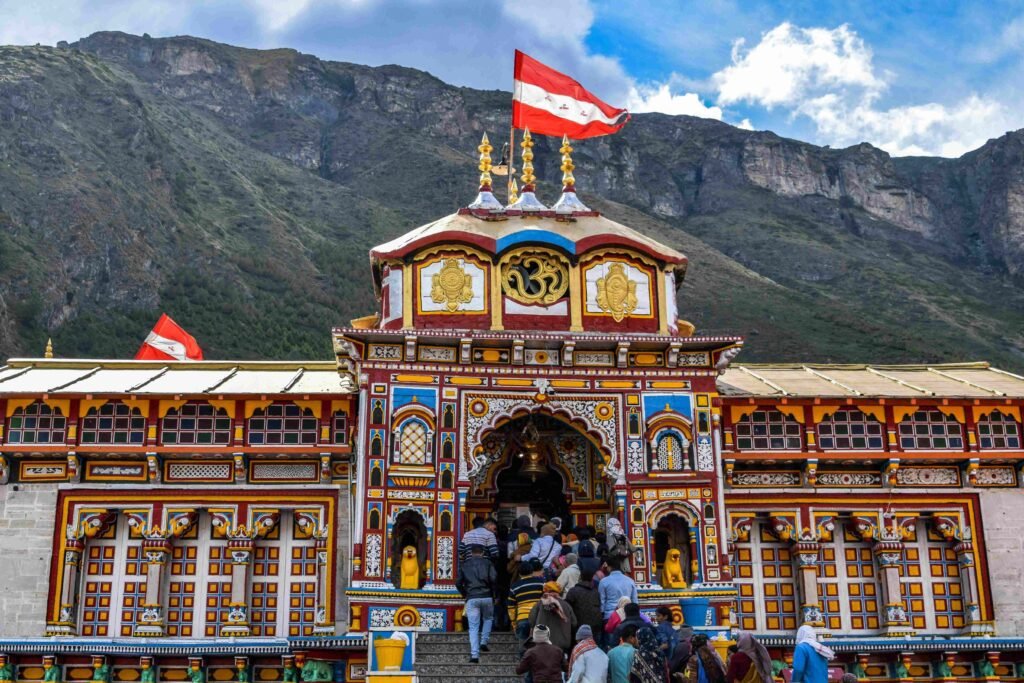
The Badrinath temple is one of the most sacred and widely visited pilgrimage sites in India. Dedicated to Lord Vishnu, it is part of both the Char Dham Yatra (India-wide) and the Chota Char Dham Yatra in Uttarakhand. Situated at an altitude of 3,133 m, the temple is located in the beautiful Chamoli district, surrounded by the towering Nar and Narayan mountain ranges and the crystal-clear Alaknanda River.
The temple has its origins in ancient times and was later re-established by Adi Shankaracharya in the 8th century. The main idol of Lord Vishnu here is in a meditative posture and is made of black stone (shaligram), which is believed to be self-manifested.
Badrinath is not only a holy site for Hindus but also an attractive place for travellers who admire natural beauty, snow-capped mountains and a peaceful atmosphere. The last Indian village before the Tibet border, Mana Village, is located a few kilometres from here and is another attraction for visitors.
The temple is open from May to November, and during this time, thousands of devotees and tourists from all over the world come to seek blessings and witness the divine aura of this holy place.
4. Kedarnath Temple🛕– A Sacred Journey to Lord Shiva’s Abode.
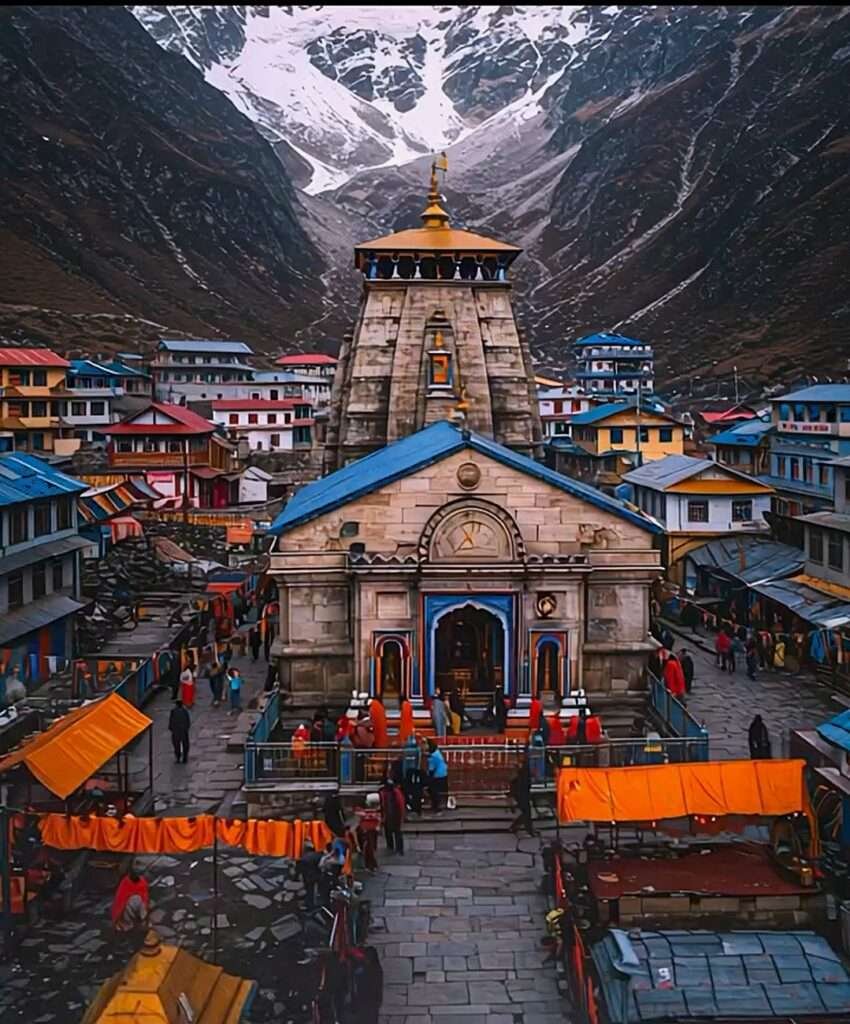
Located at an altitude of 3,583 metres in the Garhwal Himalayas, Kedarnath Temple is one of the most revered pilgrimage sites in India. Dedicated to Lord Shiva, this temple is one of the twelve Jyotirlingas and is an important part of the Char Dham Yatra. This ancient temple is believed to have been originally built by the Pandavas and later renovated by Adi Shankaracharya in the 8th century.
Kedarnath is special not only for its religious significance but also for the amazing natural beauty surrounding it. The high snow-capped peaks, the gurgling sound of the Mandakini River and the cool mountain air provide a spiritual experience that is unmatched anywhere else.
It takes a 16-km trek from Gaurikund to reach Kedarnath, although helicopter services are now available for those who cannot make the climb. Despite the arduous journey, thousands of devotees visit the temple every year, especially between April and November, when the temple is open to the general public.
Kedarnath is not just a temple – it is an emotion, a test of faith, and a journey of inner transformation.
The Char Dham Yatra is a journey of devotion, peace and inner strength. The journey to Yamunotri, Gangotri, Kedarnath, and Badrinath takes you to the heart of the Himalayas, bringing you closer to nature and God. It is a spiritual experience that lasts a lifetime.
Hemkund Sahib: A Journey to the Roof of the Divine
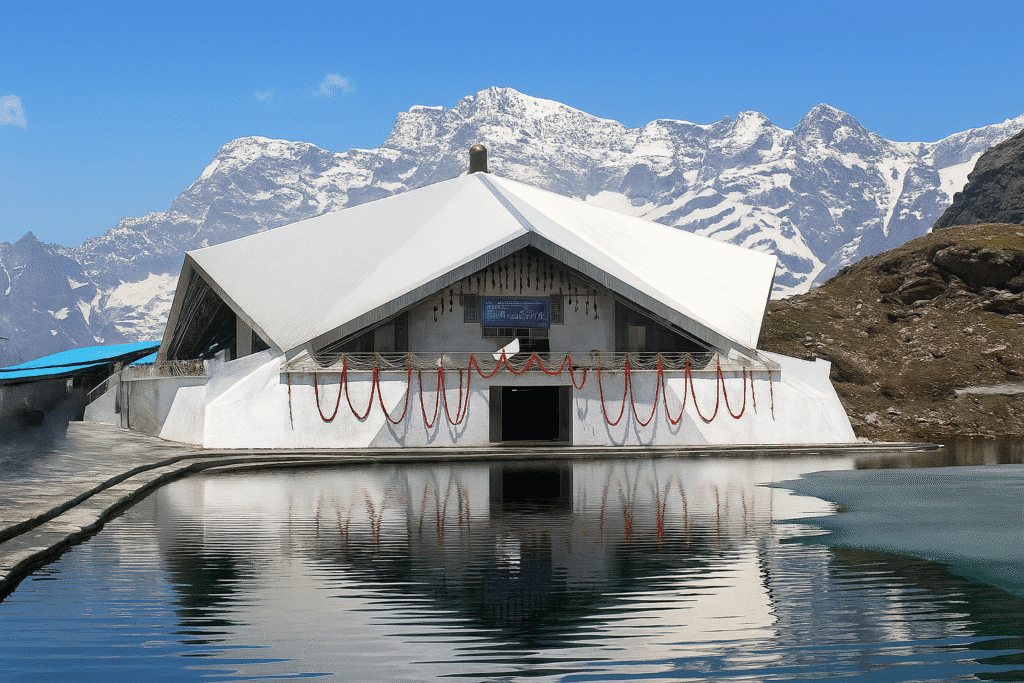
In the lap of the Garhwal Himalayas, where the breeze turns cool and the clouds kiss the snow-clad peaks, there is a place that seems closer to heaven than earth – Hemkund Sahib. Sacred, serene and mind-blowing, this Himalayan gem is not just a destination. It is a pilgrimage, a prayer and a personal awakening.
🛕 What is Hemkund Sahib?
Hemkund Sahib, also called Hemkunt Sahib, is a revered Sikh gurudwara located at an altitude of over 15,000 feet (4,572 meters) in Uttarakhand, India. It is dedicated to the tenth Sikh guru, Guru Gobind Singh Ji, who is believed to have meditated here in a previous life. The name “Hemkund” means “lake of snow“, and true to its name, the glacial lake next to the gurudwara reflects the surrounding peaks in unreal serenity.
It is not just a monument or a religious site. Hemkund Sahib is a place where faith and nature meet in its most dramatic form.
🛤️ The Trek: A Test of Body and Spirit
The journey to Hemkund Sahib is as sacred as the site itself. Pilgrims start the journey from Govindghat, crossing a steep climb of about 13 km through Ghangaria, a small village in the valley. The final leg to Hemkund is a 6-km climb, which requires strength, willpower and faith.
Every step is accompanied by chanting of hymns, snow-filled waterfalls and cheering fellow pilgrims. Old and young, locals and foreigners – everyone walks shoulder to shoulder, inspired by faith and inner strength.
“Waheguru!” reverberates in the valleys, like a call from the soul.
🌸 Beyond Religion: The Valley of Flowers Connection
Just a short distance from Ghangaria is the Valley of Flowers, a UNESCO World Heritage Site known for its lush alpine flora that blooms during the monsoon. Visiting both places together offers an unforgettable blend of spiritual fulfilment and natural beauty.
Imagine praying at Hemkund in the morning and strolling through the valley full of colours in the afternoon. It is a journey that touches both the heart and the senses.
🧘♂️ A Place to Listen Within
Hemkund Sahib is not just for Sikhs. Hindus, Buddhists, atheists, wanderers, all kinds of people come here to contemplate, recharge and reconnect. Surrounded by seven high peaks and bathed in the purest light, this is a place where your thoughts become clear, your burden lightens, and silence speaks louder than words.
Inside the gurdwara, shabad kirtan (sacred music) plays softly. Warm tea and khichdi (simple rice-lentil meal) served as langar soothe the tired body and warm the soul. There is no hurry here – only devotion.
💬 Quick Travel Tips for Hemkund Sahib Pilgrims
- Best time to visit: Mid-June to early October. The road remains closed for the rest of the year due to heavy snowfall.
- Clothing: Warm clothing, waterproof jackets and sturdy shoes are a must.
- Fitness: Basic physical fitness is a must. Consider acclimatising yourself at Ghangaria before the final climb.
- Respect: This is a sacred site. Remain silent where appropriate and follow gurdwara etiquette.
- Bonus tip: Carry a small diary. You might be inspired to write your heart out here.
✨ Final Thoughts
Hemkund Sahib isn’t meant to be a place to cross off your travel list. It’s meant to be a place to check in with yourself. It’s a place where nature’s grandeur and spiritual depth come together to remind you of something profound: peace, purpose, and presence are not destinations, but states of being, and places like Hemkund can help you find them.
Tungnath: The Highest Shiva Temple in the World
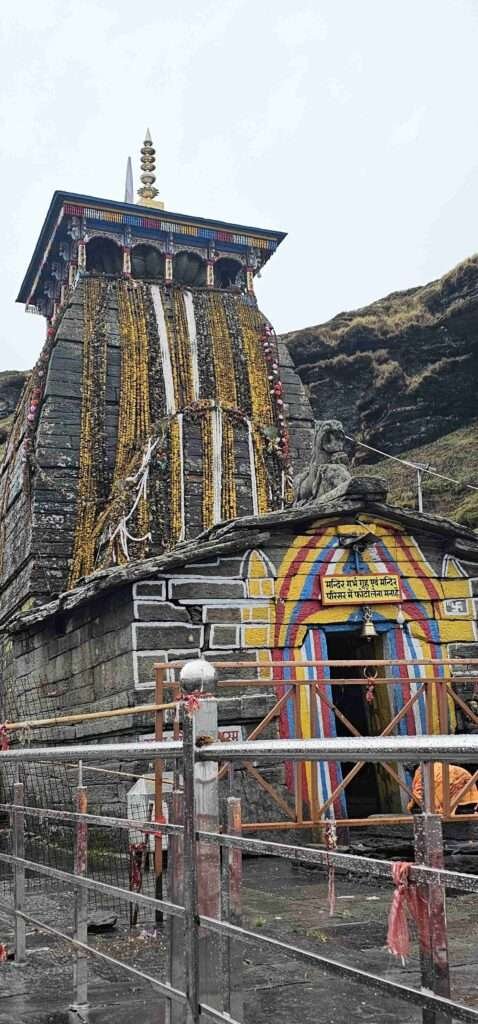
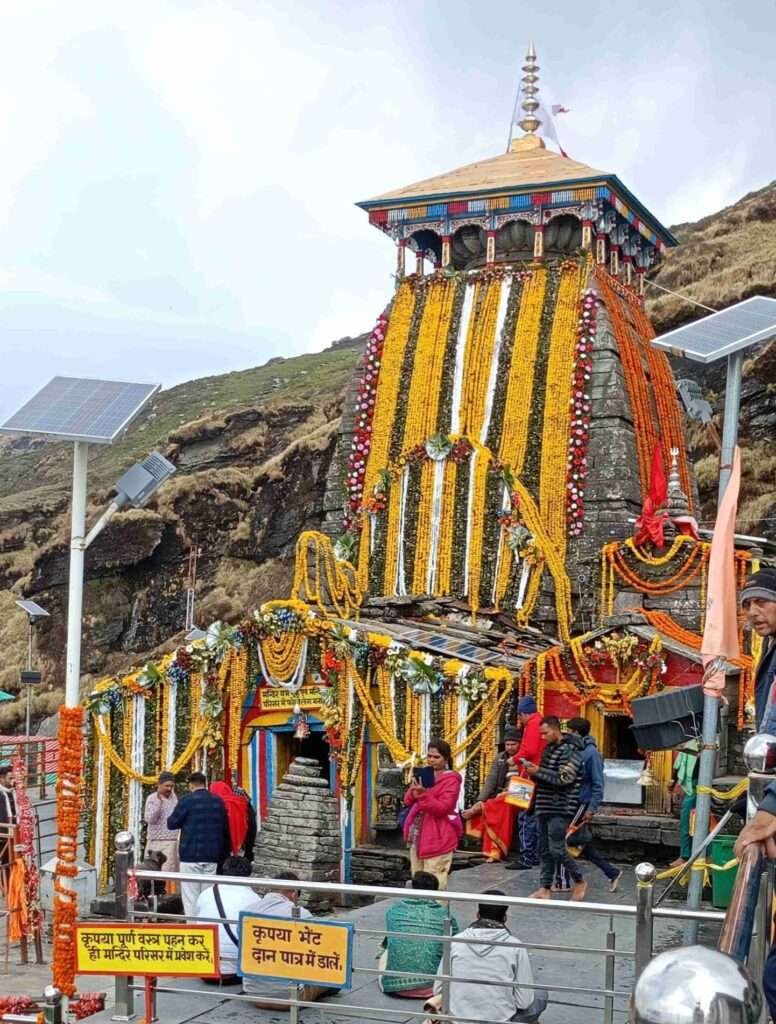
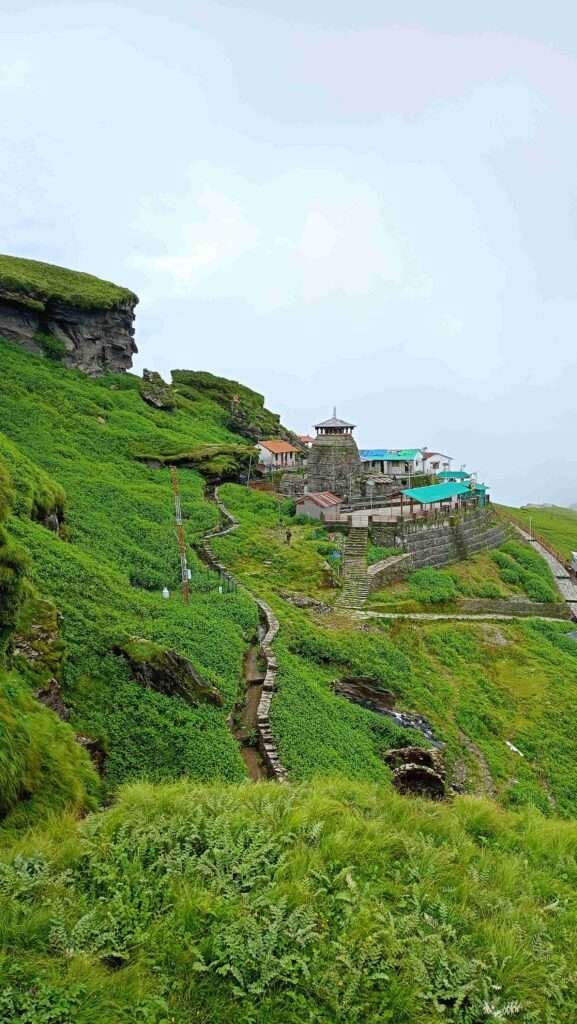
Nestled in the majestic Garhwal Himalayas of Uttarakhand, India, Tungnath is a divine and enchanting place that attracts pilgrims, trekkers and nature lovers alike. Situated at an altitude of 3,680 m (12,073 ft), Tungnath holds the title of the highest Shiva temple in the world and is one of the five sacred Panch Kedar temples dedicated to Lord Shiva.
🌄 A Temple Steeped in Mythology
Tungnath is not just a temple – it is a place of legends. According to Hindu mythology, after the Kurukshetra war, the Pandavas sought forgiveness from Lord Shiva for killing their kin. Shiva, while escaping them, took the form of a bull and vanished into the ground at Kedarnath. His arms appeared at Tungnath, his hump at Kedarnath, face at Rudranath, navel at Madhyamaheshwar and hair at Kalpeshwar – all of these together form the Panch Kedar.
The name Tungnath literally means “Lord of the peaks“, which is apt for a deity located so close to the sky.
🥾 The Trek to Tungnath
The journey to Tungnath starts from Chopta, often called the “Mini Switzerland of India.” The trek is just 3.5 kilometres (about 2.2 miles) long, making it one of the most accessible high-altitude treks in the Himalayas. Despite its short distance, the trail offers stunning views of snow-capped Himalayan peaks such as Nanda Devi, Trisul, and Chaukhamba.
- Difficulty: Easy to moderate
- Best time to visit: April to November
- Trek duration: 1–2 hours one way
The temple remains closed during winters due to heavy snowfall, but the area turns into a snowy paradise, ideal for snow trekking and photography.
🙏 Spiritual Serenity
Unlike the often crowded Kedarnath, Tungnath offers a quiet and intimate spiritual experience. The stone temple, built in the North Indian architectural style, is believed to be over 1,000 years old. Surrounded by alpine meadows and rhododendron forests, this is a place where silence speaks louder than words, and divinity feels closer than ever.
🏔️ Chandrashila: Touching the Skies
Most tourists continue their trek beyond Tungnath to Chandrashila Peak – an additional 1.5 km climb. Situated at an altitude of 4,000 m (13,000+ ft), the peak offers one of the most spectacular views of the Himalayas. Legend has it that Lord Rama meditated here after defeating Ravana.
📜 Tips for Visitors
- Altitude precautions: Drink plenty of water and take breaks to avoid altitude sickness.
- Clothing: Dress warmly, especially at the beginning or end of the season.
- Shoes: Sturdy trekking shoes are a must.
- Permits: No special permits are needed, but always check local guidelines.
💬 Final Thoughts
Tungnath is more than a destination – it is a blend of divine spirituality, Himalayan beauty and personal discovery. Whether you are looking for inner peace, an adventurous escape or a glimpse of India’s rich mythological past, Tungnath offers it all in one unforgettable trip.
Mukteshwar🌲: The Hidden Gem of Kumaon
Located at an altitude of 2,285 metres (7,497 ft) in the Nainital district of Uttarakhand, Mukteshwar is a serene, beautiful hill station surrounded by lush coniferous forests, fruit orchards and spectacular views of the snow-capped Himalayas. Far from the hustle and bustle of Nainital and Mussoorie, Mukteshwar offers a peaceful retreat, combining nature, spirituality, and adventure in perfect harmony.
🛕 Spiritual Significance: The Mukteshwar Dham
In the middle of the city is Mukteshwar Temple, an ancient Shiva temple believed to be over 350 years old. According to mythology, Lord Shiva granted salvation to a demon here, hence the name “Mukteshwar”.
- Deity: Lord Shiva
- Features: A serene climb up stone steps to reach the temple, panoramic views of the Himalayas from the summit.
- Best time for darshan: Early morning or around sunset for a divine, peaceful atmosphere.
🏔️ Adventure and Nature: A Paradise for Explorers
Mukteshwar is not just for pilgrims – it is also a paradise for trekkers, photographers, bird lovers and mountaineers.
🌄 Top Attractions & Experiences
- Chauli Ki Jaali: A dramatic cliff near the temple, known for rock climbing, rappelling and breathtaking sunset views.
- Bhau Gad Waterfall: A hidden 60-foot-high waterfall surrounded by forests – a moderate trek takes you there.
- IVRI (Indian Veterinary Research Institute): Established during the British period, the IVRI campus is worth a quiet walk.
- Orchards: In spring and summer, apple, peach, plum and apricot orchards bloom beautifully.
🌿 Offbeat Vibe and Wellness
Mukteshwar has emerged as a tranquil wellness destination. Many eco-resorts and homestays offer yoga retreats, Ayurvedic treatments and meditative stays – perfect for those who want to unwind and detox from city life.
🛏️ Where to Stay
From luxurious retreats to cosy homestays, Mukteshwar offers something for every kind of traveller:
- Luxury: The Birdcage, Casa Dream, Solitude
- Medium range: Ojasvi Resort, Mystic Mukteshwar
- Homestays: Diyo, The Moksha, Whispering Heights
🚗 How to Reach Mukteshwar
- Nearest Railway Station: Kathgodam (62 km)
- Nearest Airport: Pantnagar (90 km)
- By Road: Well connected via Bhimtal and Nainital. The drive is beautiful and pleasant.
📅 Best Time to Visit
- Summer (March to June): Pleasant weather, blooming gardens.
- Autumn (September to November): Clear skies and clear views of the Himalayas.
- Winter (December to February): Occasional snowfall; the city turns into a snowy area.
Haridwar🌊: The Gateway to the Gods
Haridwar, located in the Indian state of Uttarakhand, is one of the seven holiest cities (Sapta Puris) in Hinduism. Situated on the banks of the Ganges River, Haridwar is not just a city—it is a divine experience, a spiritual centre, and a window into the heart of India’s religious traditions.
🕉️ Mythology and Sacred Origins
The name Haridwar means “gateway to God” – ‘Hari‘ (Lord Vishnu) and ‘dwar‘ (gateway). According to legends, it is one of the four places where drops of nectar accidentally spilt during a divine battle between gods and demons. These drops fell at Haridwar, Ujjain, Nashik and Prayagraj, where the Kumbh Mela, the world’s largest religious event, is now held.
Haridwar is also where the river Ganges leaves the mountains and enters the plains, making it a particularly sacred site for rituals and purification.
🌅 Spiritual Landmarks & Experiences
🌟 1. Har Ki Pauri
- Haridwar’s most famous ghat (river bank).
- Evening Ganga Aarti: A mesmerising ritual of fire, chanting and bells every sunset.
- Pilgrims from all over the world take a holy dip here to wash away sins and attain salvation.
🛕 2. Mansa Devi Temple
- Situated on Bilva Parvat, it is dedicated to Goddess Manasa (the wish-fulfilling goddess).
- Accessible by ropeway or steep climb.
🛕 3. Chandi Devi Temple
- Situated on Neel Parvat, another Siddhapeeth.
- It can also be reached by ropeway and offers a panoramic view of Haridwar.
🧘♂️ 4. Ashrams and Yoga
- Haridwar is home to several ashrams like Shantikunj, Patanjali Yogpeeth and Sapt Rishi Ashram, which provide spiritual education, yoga, Ayurveda and Vedic studies.
🎉 Festivals and Events
🔱 Kumbh Mela
- It is held once every 12 years in Haridwar.
- Millions of devotees, sadhus, Naga Babas and international tourists participate in it.
🪔 Kanwar Yatra (July–August)
- Devotees (Kanwadiyas) walk barefoot to collect holy Ganga water for Shiva temples.
🚆 How to Reach Haridwar
- By Rail: Well connected to major Indian cities via Haridwar Junction.
- By Road: 5-6 hours drive from Delhi.
- By Air: The Nearest airport is Jolly Grant Airport, Dehradun (35 km away).
🏨 Where to Stay
- Luxury: Haveli Hari Ganga, Amatra by the Ganges
- Mid-range: Hotel Ganga Lahari, Alpana Hotel
- Budget/Ashrams: Parmarth Ashram, Shantikunj
📅 Best Time to Visit
- October to April: Pleasant weather, ideal for temple visiting and sightseeing.
- Monsoon (July-September): Lush green landscape, but may witness flooding at places.
- Festivals: Visit during Ganga Dussehra or Kartik Purnima for vibrant energy.
Rudranath Temple🕉️: The Face of Shiva in the Heart of the Himalayas
Nestled in the serene and rugged hills of the Garhwal Himalayas, the Rudranath Temple is a mystical sanctuary where nature and divinity meet. Located at an altitude of about 3,600 metres (11,800 feet), Rudranath is one of the sacred Panch Kedar temples dedicated to Lord Shiva – but unlike the other temples, it is believed to house the face of Lord Shiva.
🌄 A temple sculpted by nature
Tucked away amidst alpine meadows, dense rhododendron forests and snow-capped peaks, Rudranath is not just a pilgrimage; it is a test of faith and patience. The journey to the temple requires an arduous climb through the rugged and raw Himalayan terrain, starting from Sagar or Mandal village in Uttarakhand. Every step offers a deep spiritual connection with this land and the deity
🕉️ The Legend Behind the Temple
According to Hindu mythology, after the Mahabharata war, the Pandavas sought the blessings of Lord Shiva to be absolved of their sins. Shiva escaped them, took the form of a bull and entered the earth and reappeared in different parts of the Himalayas – these became the Panch Kedar temples. At Rudranath, it is said that his face appeared, making it the most spiritually intimate of the five Kedars.
🙏 Sacred Atmosphere
The temple itself is made of stone, nestled in a natural rock formation, and is believed to have appeared on its own. Priests from Gopeshwar perform the rituals, and the main offering here is water, as devotees believe it calms the fierce form of Rudra.
Surrounding the temple are sacred places like Surya-kund, Chandra-kund and Tara-kund, as well as panoramic views of the Trishool, Nanda Devi and Nanda Ghunti peaks – making it a place of both worship and awe.
🌌 More than a destination – a revelation
Rudranath is not just a temple; it is a spiritual experience set in the Himalayas. For those who reach its heights, it seems as if time has stopped and the veil between the mortal and the divine has been lifted. This is truly where the face of God dwells—silent, powerful, eternal.
🗓️ Best Time to Visit
- May-June: Best weather, clear skies, blooming meadows 🌸.
- July-August: Lush green, but risky due to rain ☔.
- September-October: Cool breeze, golden forests 🍂.
- November-April: Closed due to snowfall ❄️.
🕉️ Kalpeshwar Temple, Uttarakhand: The Eternal Blessing of Lord Shiva’s Locks
Kalpeshwar Temple, hidden in the enchanting Urgam Valley of Uttarakhand, is a sacred and serene abode of Lord Shiva. Unlike the other Panch Kedar temples, Kalpeshwar can be visited throughout the year, making it a unique spiritual destination for both seekers and travellers.
📍 Where Is Kalpeshwar Temple?
- Location: Urgam Valley, Chamoli district, Uttarakhand
- Altitude: About 2,200 meters (7,217 feet)
- Nearest town: Helang, on the Badrinath highway (followed by a short walk or drive to Urgam)
🕉️ Divine Significance
Kalpeshwar is one of the Panch Kedar temples and is believed to be the place where Lord Shiva’s matted locks appeared. According to legend, when Lord Shiva took the form of a bull and disappeared into the earth to escape the Pandavas, his body parts appeared at various places in the Garhwal Himalayas:
- Hump – Kedarnath
- Arms – Tungnath
- Face – Rudranath
- Navel – Madhyamaheshwar
- Hair (Jata) – Kalpeshwar
Thus, Kalpeshwar is the fifth and last temple in the Panch Kedar Circuit and has immense spiritual significance.
🛕 Temple Architecture & Atmosphere
Kalpeshwar is a small stone temple set against the backdrop of dense forests, apple orchards and steep Himalayan cliffs. To reach here, visitors walk through a quiet path along the Kalpganga River, surrounded by deodar and pine trees. The entrance is through a natural cave, which gives the temple a mystical, almost supernatural aura.
Despite its small size, the energy here is powerful. The silence of the valley, broken only by the rustling of leaves and the sound of the river, invites deep meditation and inner peace.
🌿 Spiritual Experience
- Open all year round: Unlike the other Panch Kedar temples, which close in winter, Kalpeshwar is open all year round, attracting both pilgrims and yogis.
- Remote yet enjoyable: It is less crowded, allowing visitors to experience the presence of Shiva in solitude.
- Meditation Place: Due to its powerful spiritual energy, many Rishis and Munis have meditated here for decades.
🌄 Nearby Attractions
- Helang Village – Starting point for the Kalpeshwar journey.
- Urgam Valley – Lush and quiet, with traditional Himalayan villages.
- Badrinath – A few hours’ drive, part of the Char Dham Yatra.
- Anusuya Devi Temple – A revered Shakti Peeth nearby.
✨ Kalpeshwar in a Line:
“Where Mahadev’s matted locks touch the earth, the soul attains liberation.”
🕉️ Madhyamaheshwar Temple: Where Shiva’s Navel Rises from the Earth
Situated in the remote lap of the Kedarnath Wildlife Sanctuary in Uttarakhand, the Madhyamaheshwar Temple is the third shrine of the sacred Panch Kedar shrines, where the navel of Lord Shiva is believed to have appeared. Surrounded by snow-clad Himalayan peaks, lush green meadows, and glacial streams, the temple offers not only divine darshan but also an intense encounter with nature and faith.
📍 Location & Access
- Altitude: 3,497 meters (11,473 ft).
- District: Rudraprayag, Uttarakhand.
- Nearest Town: Ukhimath (45 km drive to Ransi village, then a 16–18 km trek).
🕉️ Spiritual Significance
After the Kurukshetra war, the Pandavas atoned for the killing of their kinsmen and Brahmins. Lord Shiva, while escaping them, took the form of a bull and entered the earth at Kedarnath. His body parts appeared at various places in the Himalayas, forming the Panch Kedars.
- Kedarnath – hump
- Tungnath – arms
- Rudranath – face
- Madhyamaheshwar – navel
- Kalpeshwar – hair
At Madhyamaheshwar, the navel-shaped Shiva linga is worshipped, which represents the centre of cosmic creation and divine balance.
🛕 Temple Overview
This temple is built in the traditional North Indian Himalayan style – stone architecture with a simple, pointed shikhara. Inside the sanctum sanctorum is the black stone linga, which symbolises the navel of Shiva, who is calm and powerful in his presence.
Nearby, there is a small temple dedicated to Parvati, and behind the main temple are snow-capped peaks including Chaukhamba, Kedarnath and Neelkanth, which form a divine backdrop.
🌄 Trek to the temple
- Starts from Ransi village.
- Passes through Gaundhar and Bantoli.
- Trails pass through forests, alpine meadows and glacial streams.
- The journey is a bit tough, but spiritually and naturally rewarding.
✨ What makes Madhyamaheshwar special?
- Solitude and silence: Less commercial, offers intense spiritual peace,
- Natural beauty: Panoramic views of the Himalayas, especially from Budha Madhyamaheshwar (an elevated meadow above the temple from where one gets amazing views of the sunrise).
- Spiritual energy: Ideal for meditation and contemplation.
- Priests from South India: Like other Panch Kedar temples, rituals here, too, are traditionally performed by priests from Karnataka.
🔱 Summary in one line:
“At Madhyamaheshwar, where the centre of Shiva beats beneath the stone and the sky, the soul rediscovers its peace.”
🕉️Jageshwar Dham, Uttarakhand: Valley of Ancient Temples Where Shiva Resides
Tucked away in the dense deodar forests of Almora district, Jageshwar Dham is a sacred and ancient cluster of over 100 stone temples dedicated to Lord Shiva. This mystical site, often called the “Valley of the Gods“, is one of the oldest Shiva temple complexes in India and is considered a Jyotirlinga in some traditions – specifically the Nagesh Jyotirlinga.
📍 Location
- District: Almora, Uttarakhand
- Elevation: approx 1,870 m (6,135 ft)
- Location: Near the Jataganga River, surrounded by tall deodar trees
🛕 About Jageshwar Dham
The temple complex consists of 124 small and large stone temples, most of which were built between the 7th and 12th centuries AD with contributions from the Katyuri and Chand dynasties. These temples exhibit exquisite Nagara style architecture, with intricate carvings of deities and celestial beings.
🔱 Major Temples in the Complex
- Jageshwar Mahadev – the main temple, where Lord Shiva is worshipped as Jageshwar (Lord of the Universe)
- Dandeshwar Temple – slightly uphill; Considered more powerful and ancient
- Kubera Temple – dedicated to the God of Wealth
- Chandika Temple, Mahamrityunjaya Temple, and others
🌟 Spiritual Significance
- Some consider it to be one of the twelve Jyotirlinga sites, especially as Nagesh Jyotirlinga.
- Considered to be the penance land of ancient sages and yogis.
- According to mythology, Lord Shiva meditated here under dense deodar trees..
- The flowing Jataganga river symbolises Shiva’s matted locks, which are believed to originate under the deity.
🧘♂️ Mystical and meditative atmosphere
- The dense deodar forests, cool mountain air, and the sound of flowing water create a deeply meditative atmosphere.
- The region is rich in Shakti and Shaivite traditions, and is said to be energised by centuries of penance and worship.
- It is a place where myth, history, and nature blend seamlessly.
🗓️ Best time to visit
- March to June and September to November
- Annual Jageshwar Monsoon Festival (Shravan Mela): Held in July–August, it attracts thousands of devotees.
- Shivratri is also celebrated with great reverence.
🏞️ Nearby attractions
- Vriddha Jageshwar – an old temple site high up on a mountain
- Dandeshwar Temple Complex
- Almora – Cultural and Spiritual Hub
- Binsar Wildlife Sanctuary – for nature lovers
✨ In one line:
“Jageshwar Dham is not just a temple – it is a sacred forest where every tree breathes Shiva.”
🕉️ Neelkanth Mahadev Temple, Uttarakhand: Where Shiva Drank the Poison of the Cosmos
Nestled amidst lush green hills and gurgling rivers, Neelkanth Mahadev Temple is one of the most revered temples dedicated to Lord Shiva in Uttarakhand. Located near Rishikesh, this sacred site symbolises the mythological spot where Shiva consumed the poison Halahal during the Samudra Manthan, which turned his throat blue, hence the name “Neelkanth” (blue-throated).
📍 Location
- State: Uttarakhand
- Elevation: Approx 1,330 m (4,364 ft)
- Distance: Approx 32 km by road from Rishikesh
- Surroundings: Surrounded by the Manikut, Brahmakut and Vishnukut hills and at the confluence of the Pankaja and Madhumati rivers.
🕉️ Mythological Significance
According to Hindu mythology, during the Samudra Manthan performed by the Gods and Asuras, a deadly poison called Halahal was released. This threatened to destroy the entire creation. To save the universe, Lord Shiva drank the poison by holding it in his throat, which turned it blue, but did not harm him.
It is believed that Lord Shiva then came to Neelkanth and performed penance to reduce the effect of the poison. This temple is built at the exact spot where this incident took place.
🛕 Temple Architecture and Features
- This temple has traditional North Indian temple architecture, with intricate carvings and lifelike sculptures depicting the Samudra Manthan.
- The Shiva Linga inside the sanctum sanctorum is worshipped by thousands of devotees every day.
- A natural spring located nearby is considered sacred, and devotees often take a ritualistic bath before entering the temple.
🌿 Spiritual Atmosphere
- Surrounded by dense forests and the foothills of the Himalayas, this temple offers an extremely peaceful and invigorating atmosphere.
- The chanting of “Om Namah Shivaya” and the fragrance of incense create a divine atmosphere.
🛣️ How to Reach
- By Road: Taxis and buses are available from Rishikesh (about 1.5-2 hours by road).
- Trek Options: A popular 14-km trek from Swarg Ashram in Rishikesh offers a beautiful and spiritual journey through forests and waterfalls.
🗓️ Best Time to Visit
- October to March: Pleasant weather for darshan and trekking.
- Shivratri and Shravan month (July-August): Major festivals when thousands of devotees visit.
🛍️ Pilgrimage Traditions
- Prasad includes belpatra, coconut, honey and milk.
- Devotees tie sacred threads on temple trees to fulfil wishes.
- Special bhasma and Rudraksha beads are sold nearby.
✨ In one line:
“Neelkanth Mahadev is the place where Shiva bore the pain of the universe — and taught us the power of sacrifice and silence.”
🕉️ Dhari Devi Temple – Guardian Goddess of Uttarakhand
Located on the banks of the Alaknanda River in Uttarakhand, Dhari Devi Temple is not just a place of worship but also a guardian of the spiritual and natural balance of the region. Revered as the protector goddess of Uttarakhand, Goddess Dhari Devi is deeply connected to the cultural and mythological fabric of the state.
🌺 Significance of Dhari Devi
- Goddess: This temple is dedicated to Goddess Kali in her fierce protector form. It is believed that the upper half of the idol of Goddess Kali is enshrined in this temple, while the lower half is worshipped at the Kalimath Temple, one of the 108 Shakti Peethas.
- Protective Spirit: Locals consider Dhari Devi the protector of the Char Dham (Yamunotri, Gangotri, Kedarnath, Badrinath), and it is believed that if the goddess is disturbed or displaced, natural disasters occur.
🏞️ Historical and Spiritual Background
- The idol of the goddess is believed to have appeared on a rock centuries ago after a devastating flood.
- The original temple was located on a rocky outcrop in the middle of the river and was only accessible via a footbridge.
- Legend warns against relocating the idol—it is believed that doing so would incur the goddess’s wrath.
⚠️ 2013 Kedarnath flood connection
- In 2013, the temple was relocated for the construction of the Alaknanda Hydroelectric Project.
- Just hours later, Kedarnath was hit by a massive flood, causing massive destruction.
- Many devotees believe this was divine retribution, confirming Dhari Devi’s role as a spiritual sentinel.
🏔️ The temple today
- After the flood, the temple was rebuilt on a raised platform to maintain its sanctity and avoid any future interference.
- Pilgrims visit the temple not only to pray but also to seek protection, strength and guidance from the goddess.
🔱 Why visit Dhari Devi Temple?
- Spiritual attraction: This temple exudes a powerful energy, especially during Navratri.
- Natural beauty: Surrounded by the Himalayan ranges and the Alaknanda River, it offers a serene spiritual haven.
- Cultural reverence: Understanding and respecting the traditions of the Garhwal region.
🧘♀️ A place of strength and protection
For many, Dhari Devi is not just a goddess but a living protector who silently watches over the sacred mountains of Uttarakhand. Her legend is a reminder to respect the delicate balance of divinity and nature.
🕉️ Rishikesh: Gateway to the Himalayas & the Soul
Surrounded by the emerald-blue stream of the Ganges and in the shadow of the lofty peaks of the Himalayas, Rishikesh is more than a destination – it’s an awakening. Known as the “Yoga Capital of the World,” this holy town in Uttarakhand has been a haven for sages, seekers and those in search of truth for thousands of years.
📍 Where the soul meets nature
- Location: Foothills of the Himalayas, Uttarakhand
- River: On the banks of the Ganges
- Altitude: About 372 meters (1,220 feet) above sea level
Rishikesh is where the mighty Ganges enters the plains from the mountains, bringing with it not just water, but also purity, healing and liberation.
🧘♂️ Spiritual Pulse
Rishikesh is where ancient India breathes in the present. Whether you’re strolling the ghats, sitting in the ashrams, or meditating by the river, you feel a calm current drawing you inward.
- Yoga & Meditation: Home to world-famous ashrams like Parmarth Niketan, Sivananda Ashram, and Yoga Niketan.
- The Beatles Ashram (Chaurasi Kutia): Where the Beatles stayed in 1968, drawing the world’s attention to Indian spirituality.
- Evening Ganga Aarti: Held at Triveni Ghat, it’s a visceral experience of chanting, havans, and the sacred flame.
🛕 Temples, Myths & Pilgrimages
- Nilkanth Mahadev Temple: A short drive or trek from Rishikesh, associated with Shiva’s divine sacrifice.
- Trimbakeshwar (Tera Manzil Mandir): An Iconic 13-storey temple located on the riverbank near Lakshman Jhula.
- Laxman Jhula & Ram Jhula: Sacred suspension bridges with ancient roots in the Ramayana.
🌿 A soulful retreat and adventure hub.
- Adventure and awareness meet: Rishikesh offers a balance of spiritual depth and adrenaline, from white-water rafting and bungee jumping to trekking and camping
- Ayurveda and treatments: Rejuvenating Ayurvedic massages, panchakarma treatments and herbal medicines
- Vegetarian and sattvic cafes: Food reflects spiritual energy — pure, plant-based and nutritious
🗓️ Best time to visit
- October to April: Ideal season for yoga, trekking, rafting and spiritual exploration
- March: Celebrate the International Yoga Festival.
- July-August: Spiritual energy increases during the Shravan month and the Kanwar Yatra.
✨ Rishikesh in one line:
“Here, the Ganga flows not just through the land, but through the heart, purifying karmas and calling the soul home.”
Pingback: Valley of Flowers Trek 2025: Best Travel Guide - Desh Raahi